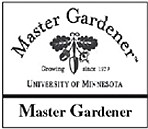September 25, 2003 at 12:13 p.m.
Symptoms of this powdery mildew occur only on the leaves. They initially appear as light green to yellow blotches ranging from 1/8 to 1/2 inch in diameter on the upper leaf surface. As the disease progresses, white mycelia develop, resembling powder. Eventually, the leaves turn yellow, dry up and drop off.
Fortunately, the management of this particular powdery mildew is not that difficult. The fungus does not over-winter outdoors in Minnesota. It must be reintroduced each year on tomato transplants grown in previously infected greenhouses or in areas of the southwest where it can over-winter. Locally grown transplants, if produced in greenhouses free of the disease, offer the best chance of healthy tomatoes.
Unfortunately, most tomato varieties available have no resistance to this disease. However, the first resistant cultivars have recently been released for commercial production. Powdery mildew is one of the most common plant diseases. I have seen it on hollyhocks, bittersweet, lilacs, agricultural crops, etc.
Although powdery mildew looks the same to the naked eye, it is caused by thousands of different fungi. In most cases, powdery mildew is very host specific. This means that the mildew on your lilacs is caused by a different species than the mildew on your roses. Therefore, the mildew on one species of plant won't affect another species.
In another article by Janna Beckerman, she writes about powdery mildew on bee balm. I have come to appreciate bee balm as one of my favorite fall flowers. Its vibrant shades of red continue to be admired until a killing frost. I planted bee balm because it is a magnet for humming birds. In addition to beautiful flowers, bee balm has wonderful lemon-scented foliage that has been used in tea. As hard as it is for us to resist bee balm, it's even harder for bee balm to resist powdery mildew.
According to Janna, there is a misconception that the native bee balm is more resistant to mildew than the newer varieties. This is not true.
Since the 1990's there have been more than 60 new cultivars of bee balm released with some progress in the battle against powdery mildew.
It's hard to believe that with the very dry summer we have experienced that there is still so much mildew around. Unlike most plant pathogens, powdery mildews do not need water to germinate. They can infect plants when the only available moisture is high humidity.
There are some things one can do to minimize the chances of powdery mildew attacking bee balm. Plants should be situated in full sun to light shade. Keeping plants well watered to reduce drought stress will minimize severe infection and defoliation in most bee balm. Bee balm is such a prolific grower so be sure to divide and thin your plants to improve air circulation. Despite this disease, bee balm has survived infection by powdery mildew for generations. So, this disease does not warrant chemical control in most cases. Remember, fungicides prevent infections from occurring and do not cure existing infections. If you can't stand this disease, it is important to treat it as soon as it appears to prevent additional infection. Some of the least toxic fungicides labeled for control of powdery mildew include potassium salts of bicarbonate, horticultural oil and sulfur. Apply additional sprays as needed according to product label directions.
To learn more about this topic or others, go to the U of M Extension Service web page at www.extension.umn.edu and search. Or, you may call our Yard and Garden Line anytime and leave a message at (612) 624-4771. A Master Gardener will return your call.




Comments:
Commenting has been disabled for this item.